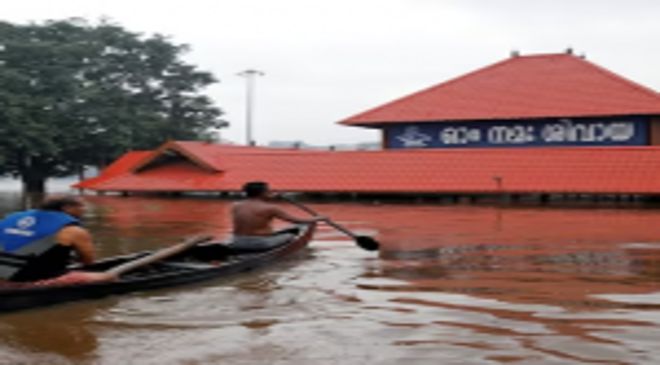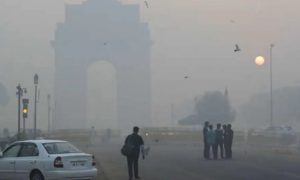The Kerala government has also come out with a new plan to reduce the effects of increasing temperatures and also to bring down greenhouse gas emissions through an ambitious programme called the ‘Cool Roof Project.
Thankachan, 54, hailing from Nattassery village in Kerala’s Kottayam district, is struggling to squeeze through the household items that are stacked up in a tiny room in his house.
The other room and the kitchen of his house were completely damaged in the worst floods that the southern state had witnessed in 2018.
He and his wife have not got a new house as part of the government’s flood rehabilitation programme and are struggling in a partially damaged house.
“They will have to pull out two dead bodies from this house if something happens again,” says Thankachan as his wife Aswathy, who is ill, looks on.
He is not in a position to even think of experiencing another flood or any other extreme weather event.
Concerns of people like Thankachan who live in vulnerable areas may grow as a study conducted by the leading scientific institutes predicts floods, flash floods, landslides, and a substantial rise in temperature in the southern state in the coming years due to climate change effects.
“There is going to be a 16 per cent increase in rainfall–either the total amount of rainfall, or average annual rainfall– by the end of this century,” says Prof K P Sudheer, Ex-Officio Principal Secretary and Executive Vice President of Kerala State Council For Science, Technology, and Environment (KSCSTE).
Sudheer was quoting the findings of a study done in 2023, that the KSCSTE has conducted jointly with the Centre for Water Resources Development and Management (CWRDM) and the Institute of Climate Change Studies (ICCS) based on the UN’s 6th Assessment Report on Climate Change. This study is yet to be submitted to the government.
An increase in annual rainfall with a reduction in rainy days, increased rainless days leading to drought spells, increase in both maximum and minimum temperatures that could considerably alter the seasons and crop patterns in the state are some of the scary findings that the study has predicted.
Read More: Over 300 lawyers From SC & HCs Object to Law Minister Rijiju’s ‘Anti-India gang’ Comments
“Increased rainfall is probably positive news. But our findings indicate that this increased volume will be delivered in fewer days compared to our usual rainy season. That means the intensity of the rainfall is going to go up,” Sudheer said, indicating that there is an increase in extreme weather events in the state.
“It is expected that there will be a 20 per cent increase in extreme events,” he added.
“We analysed around 21 ensemble climate projections given by the 6th Assessment Report, then what we did is, we used these projections, did the complete analysis in a scientific way, and ran it through a model to understand what is the water availability scenario in Kerala,” Sudheer said.
The study has also predicted a possible increase in the maximum temperature to the tune of 1.7 degrees centigrade and also in the minimum temperature an increase by 1.9 degree centigrade, which indicates that there is a shift in the range of temperature.
“While extreme events occur for a few days in a year, what is more, startling to note is that the temperature is going to substantially increase,” Sekhar Lukose Kuriakose, Member Secretary of the Kerala State Disaster Management Authority (KSDMA) and Head Scientist of State Emergency Operations Centre, told PTI.
He said after KSDMA “pushed” the Indian Meteorological Department to establish a denser weather station network in Kerala, post the 2018 and 2019 floods, and got 100 automatic weather stations established in the state, they could now monitor temperature at 100 different locations in the state.
“Now we are measuring the temperature at 100 locations, and suddenly, we, the state government, and IMD themselves realised that there are places in Kerala that have far higher temperature potential, where temperatures soared up to 39 – 40 degrees centigrade just in the beginning of March,” Kuriakose said.
The KSDMA, which had taken a proactive approach to heat management in the state and had prepared a heat action plan in 2020 itself, had to implement its plans in March, 2023. “We did not expect that we would have to do it so early,” Kuriakose said.
He said the KSDMA had established 5,000 water kiosks across the state as part of the heat action plan in order to take care of the water shortage.
“In March, we had to tell them to be ready to supply water. We had given Rs 10,000 per kiosk for keeping them ready and to do repairs if any were needed,” Kuriakose said.
According to the ‘Statement on Climate for the State of Kerala- 2022’, prepared by the ICCS, nine of the 10 warmest years on record were pertaining to the recent decade (2013-2022), and therefore the annual mean temperature of Kerala during the past decade (2011-2020/ 2013-2022) was also the warmest decade on record with the decadal averaged annual mean temperature anomaly of 0.51 Degree Centigrade / 0.58 Degree Centigrade.
“The state averaged annual maximums as well as minimum temperatures during 2022, were warmer than average,” Dr D Sivananda Pai, Director, ICCS said.
The Kerala government has also come out with a new plan to reduce the effects of increasing temperatures and also to bring down greenhouse gas emissions through an ambitious programme called the ‘Cool Roof Project.
The government has asked the local self-governments to submit Cool Roof projects for consideration in the state disaster mitigation fund.
Thankachan, or thousands like him, who are living in the flood-prone areas of Kerala, are yet to receive this information.
Government efforts are on to relocate extremely vulnerable populations from their land to safer areas by offering them cash (under a vulnerability-linked relocation scheme) and telling them that they do not have to surrender their land to the government.
The government is paying Rs 10 lakhs to families to relocate their housing from the vulnerable area, asking them to keep the land for other activities. So far more than 4,000 families have availed of this facility.
Kerala woke up to the harsh realities of climate change in 2018 when the state witnessed an unprecedented amount of rainfall and flooding. The extreme rainfall events returned in 2019, with another flood and subsequent landslides in 2020 and 2021.
In 2019, the Kerala State Planning Board constituted a technical committee with various experts under KSCSTE to examine the cause of extreme rainfall events, subsequent floods and landslides and to recommend appropriate policy responses.
After the committee submitted its report with various action plans that need to be implemented immediately, short-term, mid-term and long-term, the state government woke up to the challenge and, through KSDMA, devised many plans to effectively face the effects of climate change and its hazards in the form of extreme weather events.
The first step was to financially enable the local self-governments to act locally on the effects of climate change.
“Now all local bodies have to prepare spatial masterplans, and the spatial masterplans have to be risk-informed. So this was adopted under the law, the Municipal and Panchayati Raj Act and the concerned rules were amended, and risk-informed masterplan guidelines were adopted. So Kerala thus became the only state in the country that adopted a risk-informed masterplan,” Kuriakose said.
Many things are being done proactively, but many more things need to be done to prevent and minimise the effects of such hazards on common people like Thankachan.
The KSDMA had given concrete suggestions that people have to follow if they are constructing houses in landslide-prone/affected areas. However, an order in this regard has not been issued so far.





































